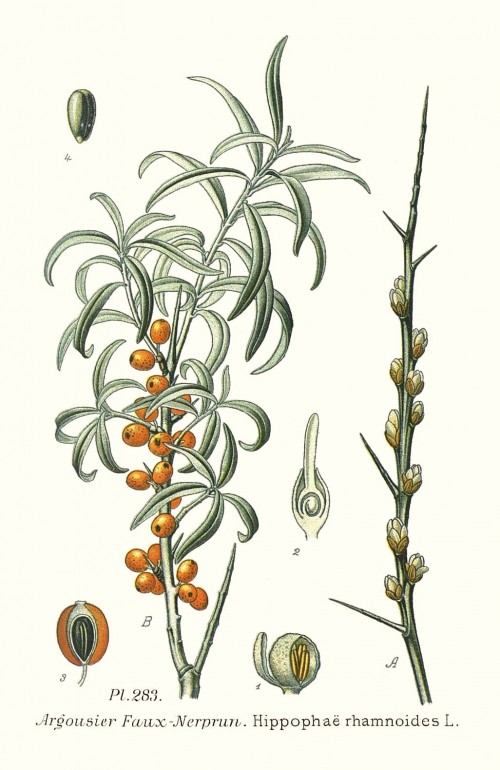Hippophae rhamnoides L. - syn. Elaeagnus rhamnoides (L.) A.Nelson - Elaeagnaceae - sea buckthorn, Sanddorn
Deciduous shrub, native to Eurasia. „The oval or lightly roundish fruits grow in compact grapes varying from pale yellow to dark orange and weighing from 0.2 g to 1 g.“ http://en.wikipedia.org/wiki/Hippophae_rhamnoides
Sea buckthorn berries have an unusually high vitamin C content: „To study the variation of vitamin C concentration between and within populations and genotypes, 701 berry samples from 71 bushes representing 10 Finnish populations of Hippophae rhamnoides were analysed. The vitamin C concentration varied from 28 to 201 mg/100 g of berries among bushes, from 60 to 122 mg among the populations.“
[Variation of vitamin C concentration and character correlation between and within natural sea buckthorn (Hippophae rhamnoides L.) populations. Yao, Yingmou, Peter MA Tigerstedt, and Peter Joy. Acta Agriculturae Scandinavica B-Plant Soil Sciences Vol.42 (1), 1992, 12-17]
„Volatile components of Sea Buckthorn fruit were studied by combined gas chromatography-mass spectrometry. A total of 60 components were identified, corresponding to about 36 mg/kg of the total volatile oil. The aroma of Sea Buckthorn fruit was characterized by the presence of several aliphatic esters such as ethyl, 3-methylbutyl and cis-3-hexen-1-yl esters. The most important compounds were ethyl hexanoate, 3-methylbutyl 3-methylbutanoate, 3-methylbutanoic acid, 3-methylbutyl hexanoate, 3-methylbutyl benzoate and 3-methylbutyl octanoate.“
[The aroma of the fruit of sea Buckthorn, Hippophae rhamnoides, L., Hirvi, Timo, and Erkki Honkanen. Zeitschrift für Lebensmittel-Untersuchung und Forschung Vol.179 (5), 1984, 387-388
 3-methylbutanoic acid (R=H, cheesy sour) ethyl 3-methylbutanoate (R=Et, fruity sweet) |  ethyl hexanoate (sweet fruity) |  ethyl octanoate (fruity wine waxy) |
„The volatile compounds of frozen berries of seven sea buckthorn (Hippophaë rhamnoides L.) varieties of two growing seasons were isolated with solid phase microextraction (SPME), and analyzed with gas chromatography mass spectrometry. A total of 45 volatiles were identified from the headspace. The most numerous compounds found were esters of short chain normal or branched alcohols and acids. Ethyl 2-methylbutanoate, ethyl 3-methylbutanoate, ethyl hexanoate, 3-methylbutyl 3-methylbutanoate, ethyl octanoate and 3-methylbutyl hexanoate were the most abundant compounds identified, and they contribute over 70% of the total peak area found in samples. Principal component analysis (PCA) showed differences between the years studied as well as between varieties. Raisa of ssp. rhamnoides origin had the highest variance in the volatile profile compared to the varieties of ssp. mongolica origin.“
[Headspace volatiles from frozen berries of sea buckthorn (Hippophae rhamnoides L.) varieties. Tiitinen, Katja, Mari Hakala, and Heikki Kallio. European Food Research and Technology 223.4, 2006 455-460]
„Using GC–MS analysis, from the headspace of sea buckthorn samples, 46 volatile compounds were separated with 43 being identified. The most abundant derivatives were ethyl esters of 2-methylbutanoic acid, 3-methylbutanoic acid, hexanoic acid, octanoic acid and butanoic acid, as well as 3-methylbutyl 3-methylbutanoate, 3-methylbutyl 2-methylbutanoate and benzoic acid ethyl ester (over 80% of all volatile compounds). Principal component analysis showed that the first two components explain 79% of data variance, demonstrating a good discrimination between samples.“
[In‐tube Extraction and GC-MS Analysis of Volatile Components from Wild and Cultivated sea buckthorn (Hippophae rhamnoides L. ssp. Carpatica) Berry Varieties and Juice. Socaci, Sonia A., et al., Phytochemical Analysis Vol.24 (4), 2013, 319-328]

Masclef,A., Atlas des plantes de France, vol.3 t.283
http://plantgenera.org/species.php?id_species=374479
Hippophae rhamnoides
© Rolf Marschner (2010),
www.botanische-spaziergaenge.at
